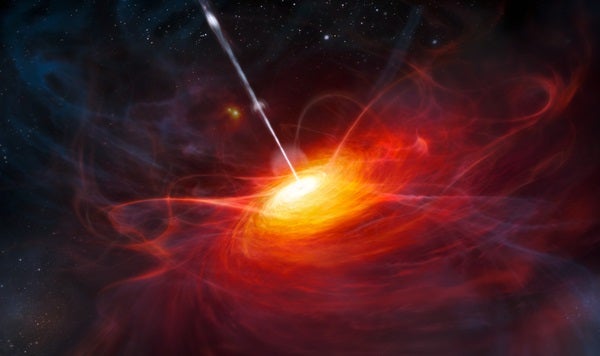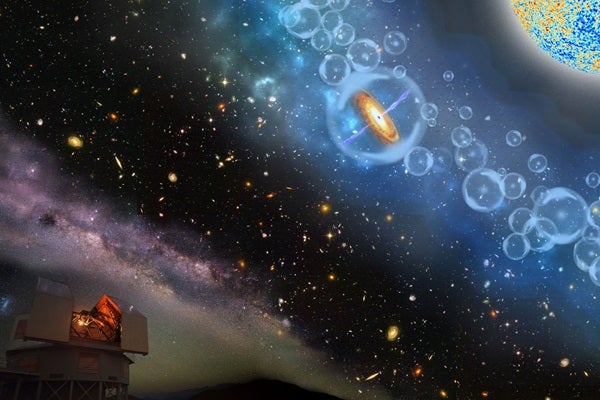J1342+0928 is a quasar — the extremely big, bright disk of infalling material around a supermassive black hole already containing 800 million solar masses at a time when the universe was just 5 percent its current age, less than 700 million years after the Big Bang. This new record-holder for the most distant supermassive black hole was found in data taken for three large surveys: the DECam Legacy Survey, NASA’s Wide-field Infrared Survey Explorer, and the United Kingdom Infrared Telescope Deep Sky Survey (UKIDSS) Large Area Survey. Its discovery was published December 6 in Nature, while details about the host galaxy containing the quasar were published in The Astrophysical Journal Letters.
How do you grow a black hole?
In today’s universe, most “new” black holes form when a massive star goes supernova. Its dense core — if it’s above a certain threshold — will collapse down into a singularity: a black hole. These stellar-mass black holes are typically a few up to 100 or so solar masses, and astronomers believe they can only grow further through accretion or mergers (such as those spotted by gravitational wave observatories).
But in the early universe, it was commonplace for black holes 100,000 times the mass of the Sun or more to form. How these literally supermassive black holes formed, especially so quickly, is still an ongoing investigation. There are several theories, but determining which one is — or ones are — correct requires knowing more about the conditions in the early universe.
And that’s where quasars like J1342+0928 come in. “Quasars are among the brightest and most-distant known celestial objects and are crucial to understanding the early universe,” said Bram Venemans of the Max Planck Institute for Astronomy in Germany in a press release. Venemans studied the host galaxy and is the first author of the Letters paper. But because they are so massive, they need at least some time to form, which is why current models predict only somewhere between 20 and 100 bright quasars as distant as J1342+0928 in the entire sky. And J1342+0928 is just the second quasar (and now the farthest) in this group ever found, now doubling the objects available to study at a unique time in the universe’s history.
The epoch of reionization
That unique time is called the epoch of reionization. Immediately after the Big Bang, the universe was a much smaller, hotter, and denser place. It of course began expanding, and cooling off in the process. By the time the universe was about 400,000 years old, it had cooled enough that particles could slow down enough to combine and form neutral hydrogen atoms. But nothing else formed for some time, until gravity finally caused some denser regions of hydrogen to collapse and form stars, and later galaxies. Once these stars and galaxies began shining, they started putting out light — photons — across the universe. These photons began to knock electrons off the neutral hydrogen gas permeating the universe, ionizing it and leaving it in the state in which it now exists, today. The time when this occurred is called the epoch of reionization. This epoch “was the universe’s last major transition and one of the current frontiers of astrophysics,” said Carnegie astronomy Eduardo Bañados, leader of the team that discovered the quasar.
The era of big data
This amazing find may only just now be possible because of the amount of data coming out of the large, all-sky surveys taking place today. “This is a very exciting discovery, found by scouring the new generation of wide-area, sensitive surveys astronomers are conducting,” said Daniel Stern of NASA’s Jet Propulsion Laboratory in Pasadena. “With several next-generation, even-more-sensitive facilities currently being built, we can expect many exciting discoveries in the very early universe in the coming years.”
Those facilities include — at least in the optical — the Giant Magellan Telescope (GMT) and the Large Synoptic Survey Telescope (LSST). The GMT will boast an optical reflecting surface of 80 feet (24.5 meters), and yield 10 times better resolution than the Hubble Space Telescope. LSST will “produce the deepest and widest image of the universe,” according to the project’s website, with its 27-foot (8.4 m) mirror and 3,200-megapixel camera.
This new era of big data gives astronomers a better chance to find those rare, hard-to-see objects that would otherwise be extremely difficult or even impossible to find — objects like the distant quasar J1342+0928, which is working to light up the young universe around it.











